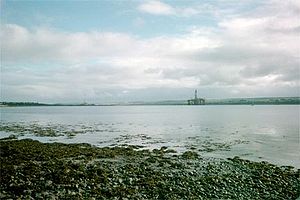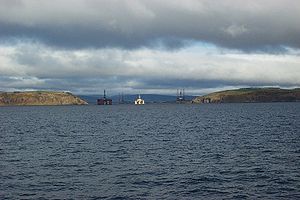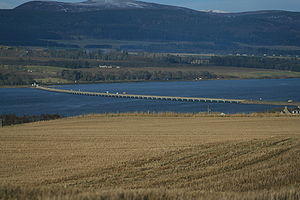- Cromarty Firth
-
 Looking from Invergordon toward oil platforms in Cromarty Firth.
Looking from Invergordon toward oil platforms in Cromarty Firth.
The Cromarty Firth (Scottish Gaelic: Caolas Chrombaidh, pronounced [kʰɯːlˠ̪əs̪ xɾɔumbaj]; literally 'Kyles (Straits) of Cromarty') is an arm of the North Sea in Scotland. It is the middle of the three sea lochs at the head of the Moray Firth: to the north lies the Dornoch Firth, and to the south the Beauly Firth.
The entrance to the Cromarty Firth is guarded by two precipitous rocks — the one on the north 400 feet (121.92 m) high and the one on the south 463 feet (141.12 m) high — called "The Sutors" from a fancied resemblance to a couple of shoemakers (in Scots, souters) bent over their lasts. From the Sutors the Firth extends inland in a westerly and then south-westerly direction for a distance of 19 miles (30.6 kilometres). Excepting between Nigg Bay and Cromarty Bay where it is about 5 miles (8 kilometres) wide, and Alness Bay where it is 2 miles (3.2 kilometres) wide, it has an average width of 1 mile (1.6 kilometre). The southern shore of the Firth is formed by a peninsula known as the Black Isle. The best view of the whole Firth is from the top of Fyrish.
At its head the Firth receives its principal river, the River Conon, and other streams it receives include the Allt Graad, Coruon, Peffery, Sgitheach and Alness. The Dingwall Canal remains connected to the Firth, although it is now disused. The principal settlements on its shores are Dingwall near the head, Cromarty near the mouth (from which the Firth takes its name), and Invergordon in between. The villages of Evanton, Alness and Culbokie are nearby.
The Firth forms one of the safest and most commodious anchorages in the north of Scotland and Invergordon was once at one time a major base for the Royal Navy's Home Fleet. The Firth was the scene of the Invergordon Mutiny in 1931. Remnants of the Navy remain, such as the disused airfield near Evanton (now an industrial estate) which was built to take aircraft from the fleet carriers while they were at anchor. During World War II, there was a large training and operational base for Catalina amphibians and Sunderland seaplanes, which extended from Invergordon to Alness point - also now an industrial estate. A memorial to the men who were killed on operational missions was placed at this industrial estate in 2001. A propeller from a Catalina was found and restored by RAF apprentices and now resides in the town of Alness. The tennis courts on the industrial estate are the only remaining parts of the estate which date from World War II.
The firth is a designated as a Special Protection Area for wildlife conservation purposes. There is one bridge, the A9 road bridge, most of which is a causeway. In the past there were several ferries across the firth (for example at Foulis) but now there is only one, a two-car ferry that runs between Cromarty and Nigg during the summer.
Oil industry
Cromarty Bridge taking A9 across the Firth north east of Dingwall
The settlement of Nigg is an important North Sea oil centre. Former Halliburton subsidiary Kellogg, Brown and Root owns the 170-acre (0.69 km2) fabrication yard south of the settlement of Nigg. This is an important North Sea oil centre with a dry dock for repairing and fabricating oil platforms. The yard was opened in 1972 as a joint venture between Brown & Root (as it then was) and construction giant George Wimpey. Today the yard is known as KBR Caledonia Ltd.
In late 2004, KBR was named as a possible "physical integrator" for the Royal Navy future aircraft carrier, in this role it was to manage the "carrier alliance"; BAE Systems, Thales and the UK Ministry of Defence. Following suggestions that KBR wished to assemble the two 60,000 tonne vessels at its Nigg Yard the MoD stated that whatever KBR's involvement assembly would take place at Rosyth.
Elsewhere along the firth are facilities for cruise ships, oil processing, and other maritime activities.
External links
 Media related to Cromarty Firth at Wikimedia Commons
Media related to Cromarty Firth at Wikimedia Commons- Cromarty Firth Port Authority
- Map from Streetmap.co.uk
References
- Ash, Marinell (1991), This Noble Harbour.
 This article incorporates text from a publication now in the public domain: Chisholm, Hugh, ed (1911). Encyclopædia Britannica (11th ed.). Cambridge University Press.
This article incorporates text from a publication now in the public domain: Chisholm, Hugh, ed (1911). Encyclopædia Britannica (11th ed.). Cambridge University Press.
Categories:- Firths of Scotland
- Ports and harbours of Scotland
- Special Protection Areas in Scotland
- Ramsar sites in Scotland
- Sites of Special Scientific Interest in East Ross and Cromarty
Wikimedia Foundation. 2010.


